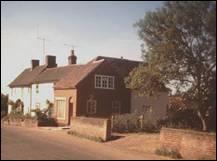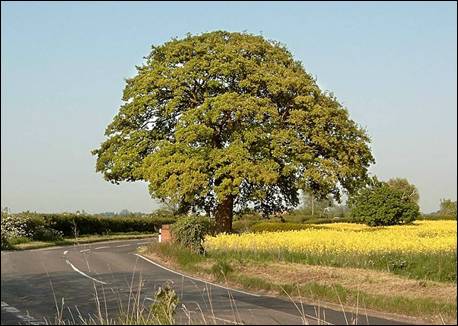o Climate around the Blackwater
o Sequoia trees in the churchyard
o A descendant of the Great Sandon Oak
o Using the salt concentration to aid radio transmissions
Walnut Trees in Goldhanger
There have always been a large number of walnut trees in the village, a tree that is not a native of the UK, and several reasons have been put forward for their presence here …
o They came with the Romans who settled in the area
o The seeds were brought back by soldiers returning from The Great War
o They may have once been grown commercially along with other fruit trees such as apples and plums
o The climate is exceptionally suitable, due to dry summers and very few late frosts
o The soil is very suitable, as they seem to seed easily and thrive
These reasons could equally apply to other villages in the immediate area, however, far fewer of these trees are to be seen in the surrounding area, and many of the established gardens in Goldhanger have one of these trees. They also appear in early photos taken around the village.
 ...
... ...
...
at the Blacksmiths in the Chequers Car park at Rectory Cottage
Sequoia trees in the churchyard
There are two healthy, large and unusual sequoia trees at the east end of St Peter’s churchyard. This tree is a native of California and is normally only seen in botanical gardens such as Kew and the Cambridge Botanical Gardens and at stately homes in the UK. Its alternative names are Coast Redwood and California Redwood. It is said to be the tallest trees on Earth and has a distinctive crown, horizontal and slightly drooping branches and a very thick, soft, fibrous bark.
|
|
It is believed that the trees in the churchyard were planted by Fish St. resident Horace Crawshay Frost during the 1950s, who amongst his other hobbies and pursuits was a keen horticulturalist. |
|
|
Sequoia trees can live for extremely long periods and these specimens could thrive in the churchyard for another 1000 years. |
|
|
Glacial ponds

The map shows that there are, and were, many ponds in and around the village, the majority of which were adjacent to farms. Some may have been “brick pits” where clay was removed for brick making. Some are said to have originally been glacial ponds, called Pingos or Kettle Holes, which were formed in the ice age when a retreating glacier left behind blocks of ice on the surface that melted and rolled down to form depressions where they stopped on flatter land and then melted. In Goldhanger the earliest farms were built adjacent to these ponds to become important drinking places for farm animals. Some of the ponds, particularly those on the through roads, would also have been used as “cart pond” where horses and carts were backed into the water to stop the wheels joints from drying out. It is highly likely that the village itself developed round this cluster of ponds and farms. The ponds shown on the map above are those that remain today plus others which no longer exist but appear on the 1820, 1838, 1880 and 1895 Maps. See also... Ancient Streams in the village

Scrotchy pond, Church St in 2007
These prehistoric ponds are known to provide an important habitat for ancient wildlife, particularly the now protected Great Crested Newt. This article is taken from the The Gazette News of Thursday 6th Jul 2000…
Goldhanger: Newts
stop new homes scheme
…Work on a housing development has been halted in a bid to save a protected species of newt. Great crested newts are believed to be living in the pond at Goldhanger near to where nine houses are being built. But wildlife experts were called in by concerned residents and the developer was told to stop work on the site after it was discovered newts were living in the ancient farm pond… …the company building the homes, will have to wait while it applies for a licence to continue groundwork because the animals are protected by law…
|
Great Crested Newt photographed in the centre of the village |
|
|
|
Today these ponds are much smaller than they were in the past and have little or no water in them during the summer months due to a general drop the water table. This 1970s aerial photo shows the extent of the Hall Farm pond at that time. |
|
This postcard was taken from the top of the Church tower in 1919 and shows the Church Farm pond in the right hand corner with far more water than it has today. |
|
There are several small stone carvings in St Peter’s Church that have newt or salamander like creatures carved amongst the ivy leaves and berries, which is an indication that the presence of these creatures has been recognised for centuries, and the salamander has a traditional association with faith and holy life.


Stone carvings in St Peter’s Church with newts
A Descendant of the Great Sandon Oak
in St Peter’s churchyard

This established and vigorously growing oak tree in the churchyard near the south door of St Peters Church, was grown from an acorn by a Goldhanger resident in the late 1960s. The acorn came from the huge oak tree on Sandon village green near Chelmsford. The famous “Sandon Oak” was planted to celebrate Queen Victoria's golden jubilee 1887 and was a hybrid of a Persian and two Spanish oaks, but was cut down in 2001 having become diseased.
The Lost Elm Trees

This picture taken in the late 1930s of cricket in “The Park” shows a row of very large Elm trees along the Maldon Road, which was formerly called The Avenue. At that time the village was surrounded by these majestic trees that grew along the roadsides and hedgerows. Some of the Elms were cut down for the WW-2 war effort, but in the early 1970s Dutch Elm Decease decimated the remaining Elm population. There was also some large specimens in the churchyard…

Salt mashes in the Estuary
|
|
Exceptionally low summer rainfall in the Blackwater Estuary results in the salt being retained in the extensive mashes and mud flats making it the saltiest estuary in the UK, which has traditionally made the location ideal for commercial salt extraction.
Natural salt at the edge of a pool near the Sailing Club ramp in 2009 |
The “Redhills” in the area have been the subject of extensive archaeological excavations in the past and they have been shown to have also been used as early potteries and salt-glazed the pottery production. The full history is at.. Salt extraction in the Blackwater. There has also been a smuggling aspect to salt production in area in the past.
|
Previously it has been said that salt production around the village came to an end in the early 1800s. However this long established tradition has now returned to the village as a new salt extraction facility has been built by the Maldon Salt Company at Longwick Farm a mile east of Goldhanger which extracts sea water and salt from Joyces Creek. The
new Maldon Salt Company facility
|
|
Amateur radio enthusiasts “DXing” also use the exceptionally salty water in the estuary to enhance their radio transmissions. See... Using the salt concentration to aid radio transmissions
Rice Grass in the Estuary


The natural looking grasses growing around the edges of Goldhanger Creek and the Estuary are not in fact native of the area, and not even very “natural”. The Spartina townsendii specie of grass, also known as Rice Grass, is a hybrid of two naturally occurring grasses that was developed in Pool Harbour on the south coast in the late 1800s that was found to be extremely tolerant of salt.
|
The grass was introduced into Goldhanger Creek, Joyces Creek and the Bounds Farm area of the Blackwater in 1928 –1930 by a team of students from the Writtle agricultural College. Stanley Wilkin of Bounds Farm and Crawshay Frost of Fish St were involved with the scheme. Wilkin & Sons of Tiptree sponsored the activity and one of Mr Frost’s many interests was horticulture.
A snippet from a Daily Mail article of 1930:
Agricultural
students taking a break on the seawall in 1930
(Crawshay Frost probably took the photo) |
|
The Majestic Oak at Wash Bridge

The majestic English Oak tree, growing at the roadside near Wash Bridge, was featured in the Goldhanger Millennium calendar published in 1999. This picture was taken in 2009 showing that the tree is still growing vigorously and remains a perfect shape.








